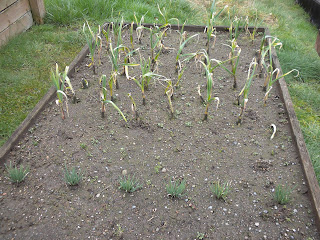What’s Happening in
My Winter Garden?
Winter vegetable gardening provides many tasty veggies for
you use throughout most of the winter here in the Puget Sound area. I plant my winter crops mostly in early August
so that I have carrots, Brussels sprouts, kale, collards, mustard, rutabagas,
turnips, red beets and cabbage in the winter.
In January I order and receive seeds for the next year as
well as ordering onion plants for growing storage onions and seed potatoes which are shipped to me in the
spring when it is time to plant. When weather permits, I remove the winter weeds that grow in the planting beds in the winter. I also fertilize the asparagus bed in February after removing any small weeds that are growing.
The above is my garlic patch. The 6 small plants in the foreground are multiplying onions. Behind the onions and in front of the garlic are 6 shallots that are just barely emerging from the soil. In the back are 56 each Roja garlic.. All of these bulbs were planted on October 26, 2012.



